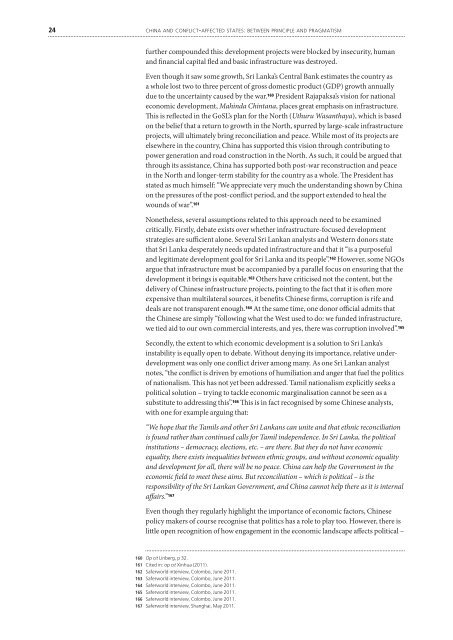FAB Sri Lanka
FAB Sri Lanka
FAB Sri Lanka
You also want an ePaper? Increase the reach of your titles
YUMPU automatically turns print PDFs into web optimized ePapers that Google loves.
24 c h i n a a n d c o n f l i c t-aff e c t e d s t a t e s: b e t w e e n p r i n c i p l e a n d p r a g m a t i s m<br />
further compounded this: development projects were blocked by insecurity, human<br />
and financial capital fled and basic infrastructure was destroyed.<br />
Even though it saw some growth, <strong>Sri</strong> <strong>Lanka</strong>’s Central Bank estimates the country as<br />
a whole lost two to three percent of gross domestic product (GDP) growth annually<br />
due to the uncertainty caused by the war. 160 President Rajapaksa’s vision for national<br />
economic development, Mahinda Chintana, places great emphasis on infrastructure.<br />
This is reflected in the GoSL’s plan for the North (Uthuru Wasanthaya), which is based<br />
on the belief that a return to growth in the North, spurred by large-scale infrastructure<br />
projects, will ultimately bring reconciliation and peace. While most of its projects are<br />
elsewhere in the country, China has supported this vision through contributing to<br />
power generation and road construction in the North. As such, it could be argued that<br />
through its assistance, China has supported both post-war reconstruction and peace<br />
in the North and longer-term stability for the country as a whole. The President has<br />
stated as much himself: “We appreciate very much the understanding shown by China<br />
on the pressures of the post-conflict period, and the support extended to heal the<br />
wounds of war”. 161<br />
Nonetheless, several assumptions related to this approach need to be examined<br />
critically. Firstly, debate exists over whether infrastructure-focused development<br />
strategies are sufficient alone. Several <strong>Sri</strong> <strong>Lanka</strong>n analysts and Western donors state<br />
that <strong>Sri</strong> <strong>Lanka</strong> desperately needs updated infrastructure and that it “is a purposeful<br />
and legitimate development goal for <strong>Sri</strong> <strong>Lanka</strong> and its people”. 162 However, some NGOs<br />
argue that infrastructure must be accompanied by a parallel focus on ensuring that the<br />
development it brings is equitable. 163 Others have criticised not the content, but the<br />
delivery of Chinese infrastructure projects, pointing to the fact that it is often more<br />
expensive than multilateral sources, it benefits Chinese firms, corruption is rife and<br />
deals are not transparent enough. 164 At the same time, one donor official admits that<br />
the Chinese are simply “following what the West used to do: we funded infrastructure,<br />
we tied aid to our own commercial interests, and yes, there was corruption involved”. 165<br />
Secondly, the extent to which economic development is a solution to <strong>Sri</strong> <strong>Lanka</strong>’s<br />
instability is equally open to debate. Without denying its importance, relative underdevelopment<br />
was only one conflict driver among many. As one <strong>Sri</strong> <strong>Lanka</strong>n analyst<br />
notes, “the conflict is driven by emotions of humiliation and anger that fuel the politics<br />
of nationalism. This has not yet been addressed. Tamil nationalism explicitly seeks a<br />
political solution – trying to tackle economic marginalisation cannot be seen as a<br />
substitute to addressing this”. 166 This is in fact recognised by some Chinese analysts,<br />
with one for example arguing that:<br />
“We hope that the Tamils and other <strong>Sri</strong> <strong>Lanka</strong>ns can unite and that ethnic reconciliation<br />
is found rather than continued calls for Tamil independence. In <strong>Sri</strong> <strong>Lanka</strong>, the political<br />
institutions – democracy, elections, etc. – are there. But they do not have economic<br />
equality, there exists inequalities between ethnic groups, and without economic equality<br />
and development for all, there will be no peace. China can help the Government in the<br />
economic field to meet these aims. But reconciliation – which is political – is the<br />
responsibility of the <strong>Sri</strong> <strong>Lanka</strong>n Government, and China cannot help there as it is internal<br />
affairs.” 167<br />
Even though they regularly highlight the importance of economic factors, Chinese<br />
policy makers of course recognise that politics has a role to play too. However, there is<br />
little open recognition of how engagement in the economic landscape affects political –<br />
160 Op cit Linberg, p 32.<br />
161 Cited in: op cit Xinhua (2011).<br />
162 Saferworld interview, Colombo, June 2011.<br />
163 Saferworld interview, Colombo, June 2011.<br />
164 Saferworld interview, Colombo, June 2011.<br />
165 Saferworld interview, Colombo, June 2011.<br />
166 Saferworld interview, Colombo, June 2011.<br />
167 Saferworld interview, Shanghai, May 2011.


